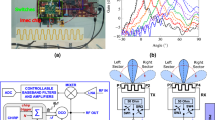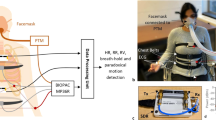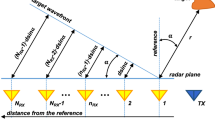Abstract
Monitoring the heart rate, blood pressure, respiration rate and breath effort of a patient is critical to managing their care, but current approaches are limited in terms of sensing capabilities and sampling rates. The measurement process can also be uncomfortable due to the need for direct skin contact, which can disrupt the circadian rhythm and restrict the motion of the patient. Here we show that the external and internal mechanical motion of a person can be directly modulated onto multiplexed radiofrequency signals integrated with unique digital identification using near-field coherent sensing. The approach, which does not require direct skin contact, offers two possible implementations: passive and active radiofrequency identification tags. To minimize deployment and maintenance cost, passive tags can be integrated into garments at the chest and wrist areas, where the two multiplexed far-field backscattering waveforms are collected at the reader to retrieve the heart rate, blood pressure, respiration rate and breath effort. To maximize reading range and immunity to multipath interference caused by indoor occupant motion, active tags could be placed in the front pocket and in the wrist cuff to measure the antenna reflection due to near-field coherent sensing and then the vital signals sampled and transmitted entirely in digital format. Our system is capable of monitoring multiple people simultaneously and could lead to the cost-effective automation of vital sign monitoring in care facilities.
This is a preview of subscription content, access via your institution
Access options
Access Nature and 54 other Nature Portfolio journals
Get Nature+, our best-value online-access subscription
$29.99 / 30 days
cancel any time
Subscribe to this journal
Receive 12 digital issues and online access to articles
$119.00 per year
only $9.92 per issue
Buy this article
- Purchase on Springer Link
- Instant access to full article PDF
Prices may be subject to local taxes which are calculated during checkout




Similar content being viewed by others
Change history
29 June 2020
The Supplementary Video files initially published online were corrupted and were replaced on 26/06/2020.
References
Patterson, R. P. Fundamentals of impedance cardiography. IEEE Eng. Med. Biol. Mag. 8, 35–38 (1989).
Payne, R. A., Symeonides, C. N., Webb, D. J. & Maxwell, S. R. J. Pulse transit time measured from the ECG: an unreliable marker of beat-to-beat blood pressure. J. Appl. Physiol. 100, 136–141 (2006).
Allen, J. Photoplethysmography and its application in clinical physiological measurement. Physiol. Meas. 28, R1 (2007).
Tamura, T., Maeda, Y., Sekine, M. & Yoshida, M. Wearable photoplethysmographic sensors—past and present. Electronics 3, 282–302 (2014).
Gong, S. et al. A wearable and highly sensitive pressure sensor with ultrathin gold nanowires. Nat. Commun. 5, 3132 (2014).
Pang, C. et al. A flexible and highly sensitive strain-gauge sensor using reversible interlocking of nanofibres. Nat. Mater. 11, 795–801 (2012).
Kindig, J. R., Beeson, T. P., Campbell, R. W., Andries, F. & Tavel, M. E. Acoustical performance of the stethoscope: a comparative analysis. Am. Heart J. 104, 269–275 (1982).
Liang, H., Lukkarinen, S. & Hartimo, I. Heart sound segmentation algorithm based on heart sound envelogram. Comput. Cardiol. http://doi.org/b2q9xp (1997).
Frinking, P. J., Bouakaz, A., Kirkhorn, J., Cate, F. J. T. & Jong, N. Ultrasound contrast imaging: current and new potential methods. Ultrasound Med. Biol. 26, 965–975 (2000).
Lin, J. C. Noninvasive microwave measurement of respiration. Proc. IEEE 63, 1530 (1975).
Chen, K., Misra, D., Wang, H., Chuang, H. & Postow, E. An X-band microwave life-detection system. IEEE Trans. Biomed. Eng. 7, 697–701 (1986).
Li, C. et al. A review on recent progress of portable short-range noncontact microwave radar systems. IEEE Trans. Microw. Theory Tech. 65, 1692–1706 (2017).
Celik, N., Gagarin, R., Huang, G. C., Iskander, M. F. & Berg, B. W. Microwave stethoscope: development and benchmarking of a vital signs sensor using computer-controlled phantoms and human studies. IEEE Trans. Biomed. Eng. 61, 2341–2349 (2014).
Wolf, R. H., Lehner, N. D. M., Miller, E. C. & Clarkson, T. B. Electrocardiogram of the squirrel monkey Saimiri sciureus. J. Appl. Physiol. 26, 346–351 (1969).
Pereira-Junior, P. P., Marocolo, M., Rodrigues, F. P., Medei, E. & Nascimento, J. H. M. Noninvasive method for electrocardiogram recording in conscious rats: feasibility for heart rate variability analysis. An. Acad. Bras. Cienc. 82, 431–437 (2010).
Kamal, A. A. R., Harness, J. B., Irving, G. & Mearns, A. J. Skin photoplethysmography—a review. Comput. Methods Programs Biomed. 28, 257–269 (1989).
Chen, K., Huang, Y., Zhang, J. & Norman, A. Microwave life-detection systems for searching human subjects under earthquake rubble or behind barrier. IEEE Trans. Biomed. Eng. 47, 105–114 (2000).
Kao, T. J., Yan, Y., Shen, T., Chen, A. Y. & Lin, J. Design and analysis of a 60-GHz CMOS Doppler micro-radar system-in-package for vital-sign and vibration detection. IEEE Trans. Microw. Theory Tech. 61, 1649–1659 (2013).
CST Microwave Studio (Computer Simulation Technology, 2017); http://www.cst.com
Zubal, I. G. et al. Computerized three‐dimensional segmented human anatomy. Med. Phys. 21, 299–302 (1994).
Yu, F., Lyon, K. G. & Kan, E. C. A novel passive RFID transponder using harmonic generation of nonlinear transmission lines. IEEE Trans. Microw. Theory Techn. 58, 4121–4127 (2010).
Patron, D. et al. On the use of knitted antennas and inductively coupled RFID tags for wearable applications. IEEE Trans. Biomed. Circuits Syst. 10, 1047–1057 (2016).
Gordon, P. H., Chen, R., Park, H. & Kan, E. C. Embroidered antenna characterization for passive UHF RFID tags. Preprint available at https://arxiv.org/abs/1710.02237 (2017).
Ma, Y., Hui, X. & Kan, E. C. Harmonic-WISP: a passive broadband harmonic RFID platform. Proc. Microw. Symp. (IMS), 2016 IEEE MTT-S Int. 1–4 (IEEE, 2016).
Hui, X., Ma, Y. & Kan, E. C. Real-time code-division multi-tag localization with centimeter accuracy. Proc. IEEE RFID Conf. 110–116 (IEEE, 2017).
Ma, Y., Hui, X. & Kan, E. C. 3D real-time indoor localization via broadband nonlinear backscatter in passive devices with centimeter precision. Proc. 22nd Int. Conf. Mobile Comput. Network. 216–229 (ACM, 2016).
Li, C., Lubecke, V. M., Boric-Lubecke, O. & Lin, J. A review on recent advances in Doppler radar sensors for noncontact healthcare monitoring. IEEE Trans. Microw. Theory Techn. 61, 2046–2060 (2013).
Adib, F., Mao, H., Kabelac, Z., Katabi, D. & Miller, R. C. Smart homes that monitor breathing and heart rate. Proc. 33rd ACM Conf. Hum. Fact. Comput. Syst.837–846 (ACM, 2015).
Pinheiro, E., Postolache, O. & Girão, P. Theory and developments in an unobtrusive cardiovascular system representation: ballistocardiography. Open Biomed. Eng. J. 4, 201–216 (2010).
Sakoe, H. & Chiba, S. Dynamic programming algorithm optimization for spoken word recognition. IEEE Trans. Acoust. Speech Signal Process 26, 43–49 (1978).
Kim, C. et al. Ballistocardiogram: mechanism and potential for unobtrusive cardiovascular health monitoring. Sci. Rep. 6, 31297 (2016).
Geddes, L. A., Voelz, M. H., Babbs, C. F., Bourland, J. D. & Tacker, W. A. Pulse transit time as an indicator of arterial blood pressure. Psychophysiology 18, 71–74 (1981).
Mukkamala, R. et al. Toward ubiquitous blood pressure monitoring via pulse transit time: theory and practice. IEEE Trans. Biomed. Eng. 62, 1879–1901 (2015).
Yeager, D. J., Sample, A. P. & Smith, J. R. in RFID Handbook: Applications, Technology, Security, and Privacy (eds Ahson, S. & Ilyas, M.) 261–278 (CRC Press, Boca Raton, 2008).
Acknowledgements
This project was supported by the US Department of Energy (DoE) under Advanced Research Projects Agency – Energy (ARPA-E) project no. DE-AR0000528. The authors thank F. Rana and J. Fan for their comments on critical applications and technical presentation, as well as H. Park for assistance with the embroidered antenna.
Author information
Authors and Affiliations
Contributions
X.H. formulated the NCS theory, performed the electromagnetic simulation and designed the experimental procedure for conceptual demonstration and calibration. E.C.K. envisioned the NCS principle, set the project goals and coordinated other project activities.
Corresponding author
Ethics declarations
Competing interests
The authors declare no competing financial interests.
Additional information
Publisher’s note: Springer Nature remains neutral with regard to jurisdictional claims in published maps and institutional affiliations.
Electronic supplementary material
Supplementary Information
Supplementary Figures 1–9 and a description of each figure.
Supplementary Video 1
The electromagnetic simulation of near-field coherent sensing by CST Microwave Studio.
Supplementary Video 2
The real-time heartbeat and pulse monitoring experiment and signal details.
Rights and permissions
About this article
Cite this article
Hui, X., Kan, E.C. Monitoring vital signs over multiplexed radio by near-field coherent sensing. Nat Electron 1, 74–78 (2018). https://doi.org/10.1038/s41928-017-0001-0
Received:
Accepted:
Published:
Issue Date:
DOI: https://doi.org/10.1038/s41928-017-0001-0
This article is cited by
-
Digitally-defined ultrathin transparent wireless sensor network for room-scale imperceptible ambient intelligence
npj Flexible Electronics (2024)
-
Radar near-field sensing using metasurface for biomedical applications
Communications Engineering (2024)
-
Early assessment of acute ischemic stroke in rabbits based on multi-parameter near-field coupling sensing
BioMedical Engineering OnLine (2022)
-
An amplitude-based characteristic parameter extraction algorithm for cerebral edema detection based on electromagnetic induction
BioMedical Engineering OnLine (2021)
-
Contactless analysis of heart rate variability during cold pressor test using radar interferometry and bidirectional LSTM networks
Scientific Reports (2021)



